Estimate and Optimize Pipe Seal Service Life through Correct Testing

Water shortages caused by an increasing number of droughts, are putting a strain on water networks across the globe.
From hosepipe bans in the UK, to Day Zero in South Africa – when water is expected to run out - it’s clear that water is a precious and increasingly scarce resource. This fact alone is making it ever more important for water networks to be as efficient and watertight as possible.
Water and wastewater pipe joints have undergone significant development over the years. It started with a simple spigot and socket solvent welded joint design. However, this was unsuitable for larger diameter pipes, so rubber rings were introduced. The use of ‘flexible’ elastomeric joints allowed for angular deflection, transverse shear load and localized pipe deformation without leakage or failure of the joint.
As the use of PVC-U pipes grew, the rubber rings had to be adapted to continue to perform. Evolving from a basic O-Ring to a lip seal design, pipe joints have become more sophisticated. Therefore, their design and characteristics must be more closely scrutinized to ensure optimum sealing performance.
However, the make-up of the pipe seal alone is not enough to guarantee watertight performance; the way it is handled during installation can make the difference between a good or a bad joint. A balance must be found between a product which is high in performance and one that is designed to aid an easy installation, for instance, a low jointing force.
Pipe performance for the long term
To ensure optimum long-term durability of the full pipeline system, engineers should consider the lifecycle environmental impacts for the whole pipeline infrastructure. While many studies have been completed on the pipe material, the elastomeric seal has generally been overlooked.
Although considered a small component in an overall pipeline system – with the cost of seals and connectors making up less than 1% of the total system spend - it is vital that a pipe seal is given due consideration. They must undergo rigorous testing to measure capabilities including sealing force, contact width and stress relaxation to establish its estimated service life.
Seal standards
One of the first standards for rubber joint rings for water mains and sewers dates back to 1955[1]. The ASTM F477 Standard Specification for Elastomeric Seals (Gaskets) for Joining Plastic Pipe was published in 1976[2], followed by ISO 4633 in 1984[3] and EN681 in 1996[4]. All of these are materials standards, which provide direction on the physical requirements of the elastomer material, including hardness classification, tensile strength and stress relaxation to name a few.
A pipe joint assembly must remain watertight throughout its working life and a significant factor in achieving this is to ensure that the physical characteristics of an installed seal can be sustained at, or above, accepted levels.
Over time, the contact pressure in a joint decreases due to relaxation of the rubber seal. In this time-dependent relaxation process, the rubber relieves a part of the imposed compressive stress by reorientation of the polymer chains in the rubber material. This reorientation is non-elastic and will result in a permanent reduction in contact pressure, which increases the risk of infiltration and exfiltration.
Stressing the importance of seal testing
When an elastomer seal is first installed in a pipe joint, a state of physical relaxation occurs for around 30 minutes, before the sealing force becomes stable. This sealing force value is then used to estimate the effective lifetime of the seal. By exposing the elastomer to a series of elevated temperatures during testing, the relation between the rate of stress relaxation and temperature can be deduced. Estimates can then be made about the lifetime at a given degree of stress relaxation and at a given temperature. The relationship can be represented by the Arrhenius equation.
By using recognized and proven ISO methodology, the relaxation threshold value is then chosen – this is the maximum relaxation acceptable for the joint design and application. The time taken to reach this threshold may then be estimated. Commonly, 50% of the initial relaxation threshold value is chosen as per the ISO guide lines.
Stress relaxation testing should be conducted by a competent third-party testing house as they should ‘blind’ test each elastomer without knowing which company has supplied it. This ensures optimum testing procedures are carried out, guaranteeing transparency and credible results.
One example of this, are tests conducted by Elastocon AB of Sweden, acknowledged as one of the global leaders in providing both the equipment and the testing of stress relaxation in elastomers. Using ASTM and ISO methodology, a program was set up using test pieces taken from existing seals available on the market. All tests were carried out ‘blind’ without Elastocon knowing the origin of elastomer they were testing. This ensures optimum testing procedures are carried out, guaranteeing transparency and credible results.
This table shows the results of tests that were carried out in 2018, highlighting the quality of Trelleborg’s seals:
The estimated time to 50% reduction in stress relaxation may seem extremely long and not necessary in some applications. Many network owners currently require a pipe lifetime of 120 years, but in reality, no one knows how long a system is going to be in place.
In some countries, the current rate of replacement will require pipeline systems to last in excess of 800 years! At the current rate of replacement, a seal that is designed to last more than 500 years seems like a sensible choice.
Quality of the compound
The quality, material formulation and how it is processed can make a huge difference in the elastomer compound’s sealing performance over time. High-quality compounds show less relaxation and thus deliver a longer service life.
The optimum elastomer compound should include a high polymer content, low compression set, good crosslink density, and a good vulcanization system. When applied correctly, high-performance compounds will continue to apply the necessary interface pressure for more than 100 years.
Conclusion
In a time when water usage is becoming more closely scrutinized, it is important to look for effective ways to save water and make water networks perform more efficiently. Pipe leaks can be a thing of the past if the industry is willing to put the weakest part of the pipe – the joint – under sufficient scrutiny.
A high-quality elastomer compound which has been through rigorous testing in order to meet industry standards, will deliver a long service life. In turn, this will mean that the contact pressure of the joint remains secure and the risk of unwanted infiltration and exfiltration is reduced.
Given the running battle that network owners, engineers and contractors face, fixing aging pipe systems to prevent water loss, sinkholes, and other major challenges, the time for durable, money-saving water asset management solutions is now.
[1] BS 2494:1955 Rubber Joint Rings for Gas Mains, Water Mains and Sewers
[2] ASTM F477: 14 Standard Specification for Elastomeric Seals (Gaskets) for Joining Plastic Pipe
[3] ISO 4633: 2015 Rubber seals. Joint rings for water supply, drainage and sewerage pipelines
[4] EN 681: 1996 Elastomeric seals. Material requirements for pipe joint seals used in water and drainage applications


